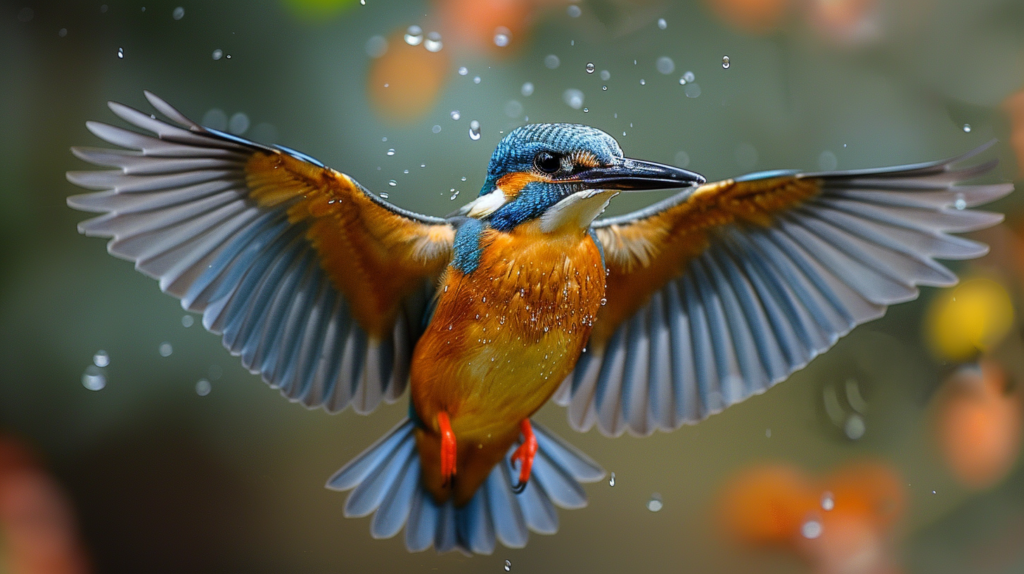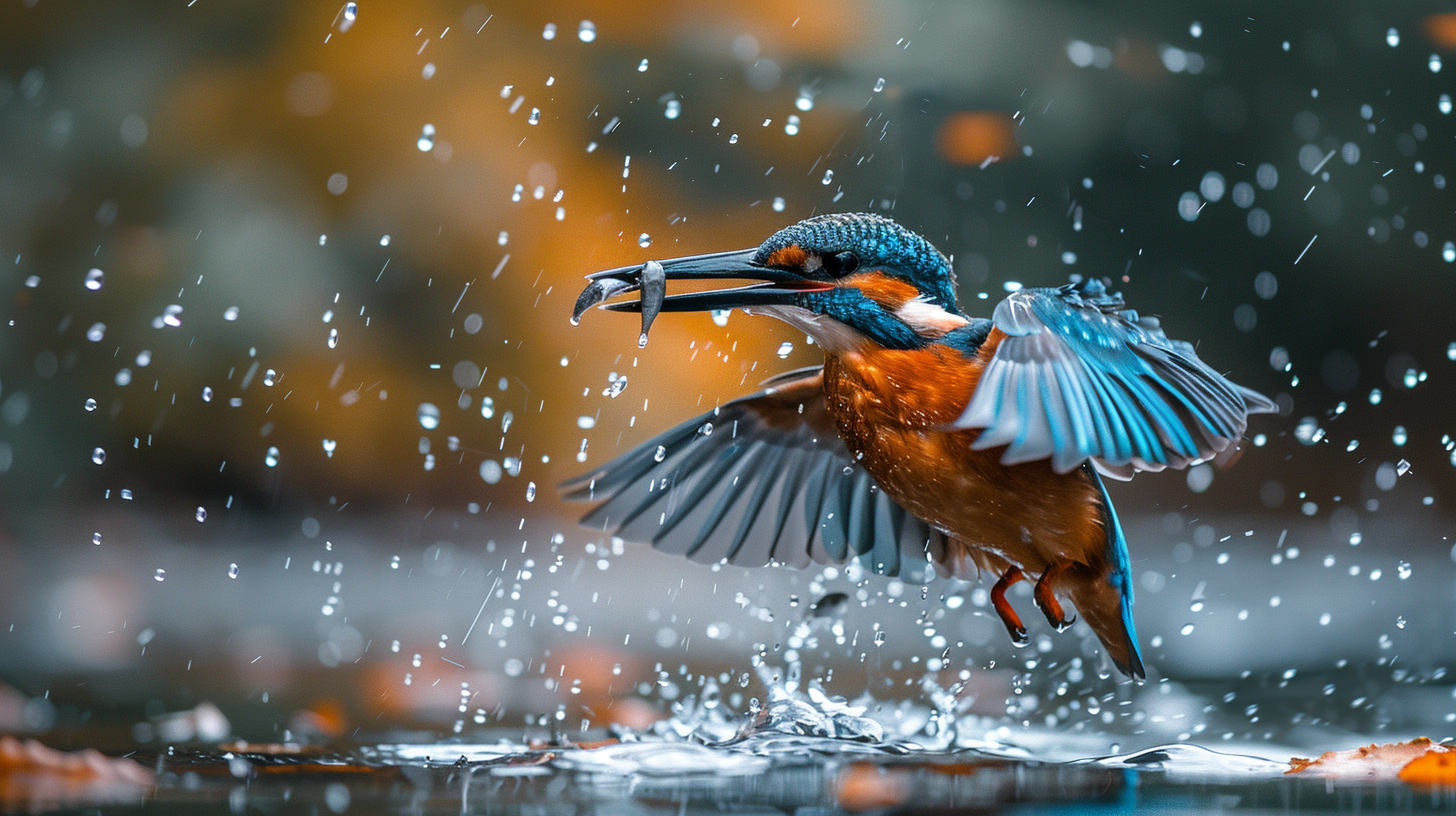Discover 8 amazing facts about the Kingfisher Bird, from their incredible 25mph diving speeds to unique tunnel nesting behaviors. Learn about conservation, habitat needs, and observation tips from wildlife experts.
Did you know that the Kingfisher Bird can dive into water at speeds of up to 25 miles per hour with pinpoint accuracy? These remarkable birds are among nature’s most skilled hunters, yet many pet enthusiasts and bird lovers know surprisingly little about their fascinating behaviors and characteristics. Whether you’re a backyard bird watcher, considering attracting kingfishers to your property, or simply curious about these stunning creatures, understanding the Kingfisher Bird can deepen your appreciation for avian wildlife.

The Kingfisher Bird represents one of the most successful fishing specialists in the animal kingdom, with over 90 species found across six continents. From their iridescent plumage that changes color depending on the light to their unique nesting habits that involve digging tunnels in riverbanks, kingfishers showcase evolutionary adaptations that have allowed them to thrive for millions of years. These birds have captivated humans throughout history, appearing in folklore, mythology, and even inspiring technological innovations.
When I first spotted a belted kingfisher during a morning walk along the Potomac River in Virginia, I was struck by its distinctive rattling call and the way it seemed to hover motionlessly above the water before executing a perfect dive. That moment sparked my interest in learning everything I could about these incredible birds and their role in our ecosystem.
1. The Kingfisher Bird’s Extraordinary Diving Abilities
The Kingfisher Bird possesses one of nature’s most impressive hunting techniques. These birds can calculate the refraction of light in water, allowing them to accurately target fish despite the visual distortion caused by the water’s surface. When diving, kingfishers close their eyes and rely on precise muscle memory and spatial awareness developed through countless hunting attempts.
Biomechanical Precision in Action
Research conducted by the Royal Society of Biology has shown that kingfishers adjust their diving angle based on water depth and fish size. Their streamlined bodies and specialized neck muscles allow them to absorb the impact of hitting water at high speeds without injury. The bird’s beak acts like a spear, designed to penetrate water with minimal splash, which could otherwise alert prey to danger.
Most remarkably, kingfishers have a success rate of approximately 60-70% when hunting, significantly higher than many other fishing birds. This efficiency stems from their ability to process visual information rapidly and make split-second adjustments during their dive sequence.
Energy Conservation Strategies
Unlike many diving birds that rely on buoyancy, kingfishers must actively swim back to the surface after each dive. To conserve energy, they typically hunt from perches 3-10 feet above water, allowing gravity to assist their descent while maintaining optimal striking angles.
2. Spectacular Plumage and Color-Changing Properties
The iridescent feathers of the Kingfisher Bird contain microscopic structures called iridophores that reflect light in specific wavelengths. This creates the brilliant blues, greens, and oranges that make kingfishers among the most visually striking birds in North America and Europe.
The Science Behind the Shimmer
These structural colors differ from pigment-based colors found in most birds. Instead of absorbing certain wavelengths of light, the feather barbules contain thin plates that interfere with light waves, creating the metallic sheen that characterizes kingfisher plumage. This means that kingfisher colors can appear to change dramatically depending on viewing angle and lighting conditions.
Interestingly, this same principle has inspired human technology, including the development of more efficient solar panels and advanced optical coatings. Scientists studying kingfisher feathers have unlocked secrets about light manipulation that continue to influence modern engineering.
Seasonal Plumage Variations
While kingfishers don’t undergo dramatic seasonal color changes like some birds, their plumage does show subtle variations throughout the year. During breeding season, colors become more vibrant, and males often display more pronounced blue coloration to attract mates.
3. Unique Nesting Behaviors and Tunnel Engineering
Kingfisher Bird species are among the few birds that create elaborate underground nesting systems. Using their beaks and feet, mated pairs excavate tunnels in riverbanks, cliff faces, or artificial embankments that can extend 3-12 feet into the earth.
Architectural Marvels
These tunnels typically slope upward from the entrance to prevent flooding and feature an enlarged chamber at the end where eggs are laid. The engineering is so sophisticated that the tunnels remain structurally sound for multiple breeding seasons, with some being reused by successive generations.
The excavation process can take 10-20 days, with both male and female kingfishers taking turns digging. They use a technique of flying directly into the bank face repeatedly, gradually loosening soil and debris that they then remove with their feet.
Environmental Adaptations
In areas where suitable riverbanks aren’t available, kingfishers have adapted to use artificial structures such as sand quarries, road cuts, and even large tree roots. This flexibility has helped maintain stable populations despite habitat modifications caused by human development.
4. Complex Social Structures and Territorial Behaviors
Contrary to popular belief that kingfishers are solitary birds, they actually exhibit sophisticated social behaviors, particularly during breeding season. Kingfisher Bird pairs engage in elaborate courtship rituals that include fish-offering ceremonies and synchronized flying displays.
Courtship and Pair Bonding
Male kingfishers demonstrate their hunting prowess by catching fish and presenting them to potential mates head-first, allowing the female to swallow the offering easily. This behavior serves multiple purposes: it shows the male’s ability to provide food, demonstrates territory quality, and helps establish pair bonds.
Once paired, kingfishers maintain strong territorial boundaries, with some pairs defending stretches of waterway up to 2 miles long. They use a variety of calls and physical displays to communicate with neighbors and warn away intruders.
Cooperative Breeding Behaviors
In some kingfisher species, particularly those in tropical regions, young birds from previous broods may help their parents raise new offspring. This cooperative breeding system increases survival rates and allows experienced hunters to pass skills to the next generation more effectively.
5. Remarkable Hunting Intelligence and Problem-Solving Skills
The cognitive abilities of the Kingfisher Bird extend far beyond instinctual hunting behaviors. Recent studies have documented kingfishers using tools, solving complex problems, and even showing evidence of planning future actions.
Tool Use and Innovation
Several kingfisher species have been observed using leaves, twigs, and even artificial objects as fishing aids. Some position themselves behind natural or artificial barriers to ambush prey, while others have learned to follow human fishing activities to capture disoriented fish.
In urban environments, kingfishers have adapted their hunting strategies to take advantage of fish farms, decorative ponds, and even swimming pools where fish have been accidentally introduced.
Learning and Memory
Kingfishers demonstrate remarkable spatial memory, remembering the locations of productive fishing spots and returning to them at optimal times based on fish behavior patterns. They also learn from unsuccessful hunting attempts, adjusting their techniques based on water conditions, weather, and seasonal fish movements.
Table 1 – Kingfisher Hunting Success Factors
| Factor | Impact on Success Rate | Optimal Conditions |
|---|---|---|
| Water Clarity | High | Clear to slightly turbid |
| Fish Depth | Medium | 6-18 inches below surface |
| Perch Height | High | 4-8 feet above water |
| Weather Conditions | Medium | Calm, overcast days |
| Time of Day | High | Early morning, late afternoon |
| Seasonal Timing | Medium | Spring and fall migrations |
6. Ecosystem Impact and Environmental Indicators
Kingfisher Bird populations serve as crucial indicators of aquatic ecosystem health. Their presence typically signifies clean water, abundant fish populations, and stable riverbank habitats. Conversely, declining kingfisher numbers often indicate environmental problems that require immediate attention.
Water Quality Monitoring
Because kingfishers feed exclusively on fish and aquatic prey, they bioaccumulate toxins present in their food chain. Environmental scientists monitor kingfisher health to detect pollution levels, particularly heavy metals and pesticides that can devastate aquatic ecosystems.
Studies have shown that areas with healthy kingfisher populations correlate strongly with high water quality ratings and diverse fish communities. This makes kingfishers valuable sentinel species for conservation efforts.
Predator-Prey Balance
Kingfishers help maintain balanced fish populations by preferentially targeting sick, weak, or overly abundant species. This natural selection pressure improves overall fish health and prevents any single species from dominating aquatic habitats.
Their hunting activities also benefit other wildlife. Kingfisher diving creates disturbances that bring smaller organisms to the surface, providing feeding opportunities for surface-feeding birds and insects.
7. Global Distribution and Habitat Adaptations
The Kingfisher Bird family includes species adapted to virtually every aquatic environment on Earth, from tropical rainforest streams to arctic coastal areas. This remarkable adaptability showcases the evolutionary success of the kingfisher body plan and hunting strategy.
North American Species
The belted kingfisher is the most widespread North American species, ranging from Alaska to Panama. These birds demonstrate exceptional versatility, hunting in everything from mountain streams to coastal estuaries. During winter, northern populations migrate to ice-free waters, sometimes traveling over 2,000 miles.
European Adaptations
European kingfishers face unique challenges, including habitat fragmentation and increased human activity along waterways. However, they’ve shown remarkable resilience, adapting to urban environments and even nesting in artificial structures when natural sites aren’t available.
Migration Patterns and Seasonal Movements
While some kingfisher species are year-round residents, others undertake impressive migrations. Arctic-breeding kingfishers may travel thousands of miles to reach wintering grounds, navigating by landmark recognition and possibly magnetic field detection.
Table 2 – Global Kingfisher Species Distribution
| Region | Number of Species | Notable Characteristics | Conservation Status |
|---|---|---|---|
| North America | 3 | Large size, migratory behavior | Stable |
| Europe | 1 | Smallest species, highly territorial | Declining |
| Asia | 35+ | Greatest diversity, tropical specialists | Variable |
| Africa | 18 | Desert and savanna adaptations | Stable |
| Australia | 10 | Unique cooperative breeding | Stable |
| South America | 5 | Rainforest specialists | Declining |
8. Conservation Challenges and Success Stories
Modern Kingfisher Bird conservation faces unique challenges related to habitat modification, climate change, and human development pressures. However, targeted conservation efforts have produced remarkable success stories that provide hope for the future.
Habitat Restoration Initiatives
Successful kingfisher conservation projects focus on riverbank restoration, fish population management, and creating artificial nesting sites where natural banks have been destroyed. The Thames River restoration project in England has seen kingfisher populations increase by over 400% since the 1980s through coordinated habitat improvements.
Climate Change Adaptations
Rising temperatures are shifting fish distributions and altering river flow patterns, forcing kingfishers to adapt their hunting strategies and migration routes. Some populations are showing remarkable flexibility, with northern species extending their ranges and tropical species moving to higher elevations.
Community Involvement Programs
Citizen science projects involving kingfisher monitoring have become crucial for conservation efforts. Birdwatchers and nature enthusiasts contribute valuable data about population trends, breeding success, and habitat preferences that inform management decisions.
Warning Signs for Kingfisher Health
Pet owners and wildlife enthusiasts should watch for these concerning signs in local kingfisher populations:
- Decreased calling activity during breeding season
- Birds remaining motionless for extended periods
- Unusual hunting behaviors or repeated failed diving attempts
- Presence of injured or disoriented individuals
- Absence from previously occupied territories during appropriate seasons
When to Contact Wildlife Professionals
If you observe kingfishers showing signs of distress, injury, or unusual behavior, contact local wildlife rehabilitation centers immediately. Never attempt to capture or handle wild kingfishers, as they can inflict serious injuries with their sharp beaks and may be carrying diseases transmissible to humans.
Professional wildlife veterinarians can assess kingfisher health issues and provide appropriate treatment. They can also test for environmental contaminants that might indicate broader ecosystem problems affecting multiple species.
Common Misconceptions About Kingfisher Birds
Myth: Kingfishers Only Eat Fish
While fish comprise the majority of their diet, Kingfisher Bird species are opportunistic hunters that also consume crustaceans, amphibians, insects, and even small reptiles. During fish scarcity, they adapt their hunting techniques to capture alternative prey sources.
Myth: All Kingfishers Live Near Water
Although most species are associated with aquatic habitats, some kingfishers have evolved to hunt in forests, grasslands, and even desert environments. These terrestrial kingfishers focus on insects, small mammals, and reptiles rather than fish.
Myth: Kingfishers Are Aggressive Toward Humans
Kingfishers are generally wary of human presence but not aggressive unless directly threatened or protecting active nests. Their loud calls and dramatic flight patterns are communication behaviors, not signs of aggression.
For more expert pet care tips and product recommendations, visit BlithePet.com — your trusted source for pet wellness.
Table 3 – Kingfisher Conservation Status by Region
| Conservation Priority | Species Count | Primary Threats | Success Rate |
|---|---|---|---|
| Critical | 8 | Habitat loss, pollution | 25% |
| High | 15 | Climate change, development | 60% |
| Moderate | 35 | Human disturbance | 80% |
| Low | 32 | Minimal threats | 95% |
| Success Stories | 10 | Recovered populations | 100% |
Expert Tips for Observing Kingfisher Birds
Best Observation Practices
- Choose optimal timing: Early morning and late afternoon provide the best viewing opportunities when kingfishers are most active
- Position yourself downstream: Kingfishers typically hunt by diving downstream, so positioning yourself accordingly increases sighting chances
- Use quality optics: Binoculars with at least 8x magnification help you observe detailed behaviors without disturbing the birds
- Learn their calls: Familiarizing yourself with kingfisher vocalizations helps locate them even when they’re hidden
- Respect nesting areas: Maintain at least 100 feet distance from suspected nesting sites during breeding season
- Document responsibly: Photography should never interfere with natural behaviors or cause stress to the birds
- Support habitat conservation: Participate in local wetland restoration projects to maintain kingfisher populations
- Report sightings: Contribute to citizen science databases that track kingfisher distribution and population trends
Creating Kingfisher-Friendly Environments
Property owners near water bodies can take steps to attract kingfishers by maintaining fish populations, preserving natural shorelines, and avoiding excessive human activity during breeding seasons. Installing fishing perches at appropriate heights can also encourage kingfisher visits.
The Future of Kingfisher Bird Conservation
Looking ahead, Kingfisher Bird conservation will likely depend on integrating traditional habitat protection with innovative approaches addressing climate change and urbanization pressures. Advanced monitoring technologies, including satellite tracking and acoustic monitoring, provide new insights into kingfisher behavior and habitat requirements.
Collaborative efforts between wildlife organizations, government agencies, and private landowners continue to expand protected areas and restore degraded habitats. These partnerships have already produced measurable improvements in kingfisher populations across multiple regions.
The growing recognition of kingfishers as indicator species for ecosystem health has elevated their conservation priority and attracted increased funding for research and protection efforts. This trend suggests a promising future for these remarkable birds.
What aspects of kingfisher behavior intrigue you most? Have you observed any unusual kingfisher activities in your local area? Understanding these magnificent birds enhances our appreciation for the complex relationships within aquatic ecosystems and reminds us of our responsibility to protect the natural world.
Have a similar experience with your pet or local wildlife? Share it in the comments below! Don’t forget to check out our other helpful guides at BlithePet.com.
FAQ Section (Schema-Ready)
Average diving speeds reach 25 miles per hour, with some species achieving even faster velocities during hunting strikes. Their streamlined bodies and specialized neck muscles allow them to absorb the impact without injury while maintaining hunting accuracy.
Although fish comprise most of their diet, kingfishers also consume crustaceans, amphibians, insects, small reptiles, and aquatic invertebrates. During fish scarcity, they adapt their hunting techniques to capture alternative prey sources.
Expect wild kingfishers to live 6-10 years on average, though some individuals have been documented reaching 15 years. Factors affecting lifespan include habitat quality, food availability, predation pressure, and environmental conditions.
Building elaborate tunnel systems in riverbanks, cliff faces, or artificial embankments, kingfisher pairs excavate burrows 3-12 feet deep. These tunnels slope upward to prevent flooding and feature enlarged chambers for egg-laying and chick-rearing.
Conservation status varies by species and region, with most North American kingfishers maintaining stable populations. However, some European and tropical species face declining numbers due to habitat loss, pollution, and climate change impacts on aquatic ecosystems.
Attracting kingfishers requires suitable habitat including fish populations, appropriate perching sites 4-8 feet above water, and minimal human disturbance. Installing fishing perches and maintaining healthy pond ecosystems increases the likelihood of kingfisher visits.
Migration timing depends on species and geographic location, with northern populations typically moving south between September and November, returning to breeding grounds from March through May. Some kingfisher populations remain year-round residents in suitable climates.







